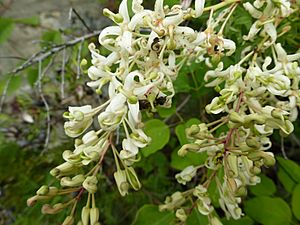Guitar plant facts for kids
Quick facts for kids Guitar plant |
|
|---|---|
 |
|
| Lomatia tinctoria in the Royal Botanic Garden Edinburgh | |
| Scientific classification | |
| Genus: |
Lomatia
|
| Species: |
tinctoria
|
The Lomatia tinctoria, often called the guitar plant, is a type of shrub. It can grow up to about 2 meters (7 feet) tall. This plant belongs to the Proteaceae family. It is one of three Lomatia species that are only found in Tasmania. The other two are L. polymorpha and L. tasmanica. Lomatia tinctoria is very similar to L. polymorpha. Sometimes, these two plants even create hybrid plants together. You can tell them apart by their leaves. L. tinctoria has divided leaves, while L. polymorpha has simple, undivided leaves.
Contents
What it Looks Like
The Lomatia tinctoria is a woody shrub. It usually grows to about 1.5 meters (5 feet) tall. Sometimes, it can reach up to 2 meters (7 feet) high. Its leaves are deeply cut or lobed. This means they have many parts, like a fern leaf. The leaves are usually around 8 cm (3 inches) long. White or cream-colored flowers grow in groups. These flower groups are called inflorescences. They appear during the summer months.
The plant is called "guitar plant" because of the shape of its fruit.
Where it Lives
You can find Lomatia tinctoria in north-eastern Tasmania. It mostly grows north and east of the Pieman River and Derwent River. It also lives on Cape Barren Island and Flinders Island. Another similar plant, Lomatia polymorpha, lives mostly south of the Pieman River and west of the Derwent River.
Sometimes, their living areas overlap. For example, near Lake St Clair, you might find hybrid plants. These are a mix of both species. This is interesting because their leaves look very different.
How it Got its Name
A French scientist named Jacques Labillardière first described this plant in 1805. He called it Embothrium tinctorium. The word tinctoria is Latin. It means "used in dyeing." This name was chosen because a part of the plant's fruit can be used to make dye. Back then, many different plants were grouped under the name Embothrium.
Later, in 1810, another botanist named Robert Brown gave it its current name, Lomatia tinctoria. He wrote about it in his book, On the natural order of plants called Proteaceae.
Growing Guitar Plants
You can grow Lomatia tinctoria in your garden. It grows best in soil that is a bit acidic and drains water well. It can grow in sunny spots or in shady areas. It is quite easy to grow new plants. You can start them from seeds or from cuttings.
More Information
- Australian Native Plants Society (Australia) website: anpsa.org.au/l-tin.html
Images for kids
-
Lomatia tinctoria in the ANBG
-
L. tinctoria x polymorpha hybrid near Lake St Clair.




